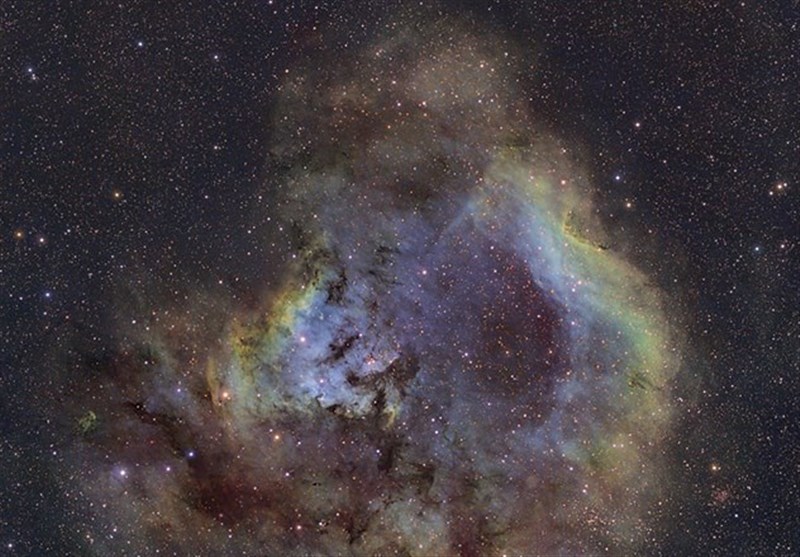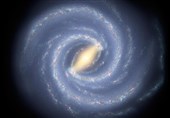Stars from Ancient Cluster Found in Milky Way
TEHRAN (Tasnim) – Galaxies like the Milky Way are thought to have been built through a series of mergers, drawing in smaller galaxies and clusters of stars and making these foreign stars their own.
In some cases, the mergers were recent enough that we can still detect the formerly independent object as a cluster of stars orbiting the Milky Way together. But, as time goes on, interactions with the rest of the stars in the Milky Way will slowly disrupt any structures the cluster incorporates.
So it's a bit of a surprise that researchers found what appear to be the remains of a globular cluster composed of some of the oldest stars around. The finding is consistent with a "growth through merger" model of galaxy construction, but it raises questions about how the cluster stayed intact for as long as it did.
The results started with an analysis of data from the ESA's Gaia mission, which set out to do nothing less than map the Milky Way in three dimensions. Gaia imaged roughly a billion objects dozens of times, enough to estimate both their location and their motion around the Milky Way's core. This map has helped scientists identify structures within our galaxy based on the fact that there are some groups of stars that are not only physically close to each other, but all moving in the same direction.
The process of mining the Gaia data for these sorts of structures is so useful that there's a software algorithm called STREAMFINDER that identifies them. That software led to the discovery of the C-19 stellar stream, a group of stars moving together through the Milky Way's halo.
One way to check whether these groups of stars really started out as part of a single cluster is to check their age; clusters are often composed of stars with similar ages. One of the ways to see if stars formed at the same time is to check the content of heavier elements. There was little in the way of elements heavier than helium formed during the Big Bang, so most heavy elements that are now present were produced by earlier stars. The later in the history of the Universe a star formed, the more of these heavier elements that star is likely to contain.
(Astronomers call any element heavier than helium a metal and refer to a star's heavy-element content as its metallicity. But this will probably confuse most non-astronomers, so we'll avoid it.)
So, the astronomers behind the new work measured the levels of heavy elements in the stars that were thought to belong to the C-19 stream. And, with the exception of one outlier, they were all quite similar, suggesting that the stream really is the disrupted remnant of a cluster. But the results also contained a surprise: a remarkably low amount of heavy elements.
The typical way of registering heavy elements is through the ratio of iron (which is only formed late in the life of massive star) to hydrogen. Hydrogen has always been the most abundant element in the Universe, while iron levels have slowly built over time. So the higher the iron-to-hydrogen ratio, the more recently the star formed.
In the case of the C-19 stream, the ratio was extremely low. So low, that the stars of C-19 would have formed prior to 3 billion years after the Big Bang, or when the Universe was only about a quarter of its current age. And they likely formed quite a bit earlier than that.
Within the Milky Way, a few hundred stars have been identified with similarly low heavy-element levels. But no cluster in which every star has such a low level has ever been seen. In fact, prior to this discovery, clusters in the Milky Way were thought to have a heavy-element floor—all of them had levels above those seen in the C-19 stream. This was true despite the fact that, based on the distribution of known clusters, we'd expect about five with heavy-element levels similar to that of the C-19 stream.
The lack of other clusters suggests that most of the earliest clusters like this stream have already been disrupted to the point that they've faded into the background of Milky Way stars. Which raises the question of why the C-19 stream hasn't. That's especially unexpected given that the stream's orbit around the galactic core takes it deep inside the Milky Way, giving it plenty of chances to engage in interactions with other features that should disrupt it.
One possibility that could explain this is that the cluster originally entered the Milky Way as part of a dwarf galaxy that was swallowed. The dwarf galaxy's structure could provide a degree of protection until it became disrupted and its stars spread through the Milky Way. And, if this were true, then the cluster that gave rise to the C-19 stream would have had a large fraction of the stars present in the dwarf galaxy at the time.
Regardless of how it ends up being explained, the presence of the C-19 stream tells us things about the history of the Universe. "The very existence of C-19 proves that globular clusters must have been able to form in the lowest-metallicity environments as the first galactic structures were assembling," the researchers conclude.






